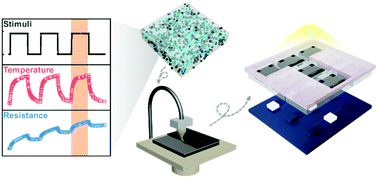Artificial visual memory device based on a photo-memorizing composite and one-step manufacturing†
Abstract
The functional deficiency between physically separated electronic components makes the up-to-date artificial photo memory devices undergo an intricate preparation and assembly process for the discrete elements, modules and final product. In this research, a multi-functional composite, which consists of conductive nanoparticles with a photothermal conversion effect and a polymeric matrix with memory characteristics, is proposed to realize the sensing and successive memory of optical information in the same material instead of device integration. Nanoparticles in the composite can convert light into heat, and heat can change the irreversible viscous flow of the polymers, which results in changing the distribution distance of conductive nanoparticles in the matrix, as well as the resistance of the composite. Therefore, the composite itself can realize light perception and memory. The composite can mimic multiple basic neuro behaviors. This new way of thinking about the polymer physical properties may open doors for polymers in the electronics area, which may be applied in future flexible and wearable electronics or even artificial intelligence with sensory demands.



 Please wait while we load your content...
Please wait while we load your content...